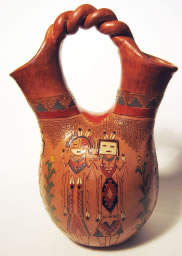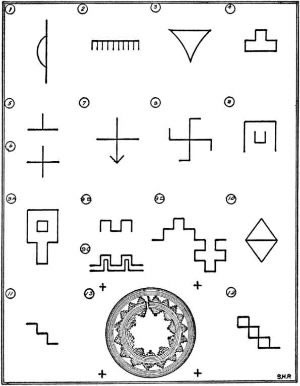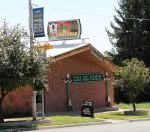Pottery Care
It's tempting to use cleaners or other traditional dusting tools on pottery, but it's important not to. Never dust pottery with a feather duster; it can take off paint or scratch the polish. It's best to dust only with a soft cotton cloth to avoid scratching the piece. It's important to remember that your pottery is decorative, not functional.
Make sure you wash you hands before handling pottery. Oils in your skin can discolor polychrome pottery. Also make sure you remove rings and bracelets that can scratch delicate pottery finishes.
Be careful not to pick up your piece by the rim and treat handles as decorative features, not handles.
Use two hands, and support the pot from the bottom. To protect the signature on the bottom of a pot, use a leather pad. Use a hair dryer to remove price tags from the bottom of bowls. And if your pot has a propensity to tip, place a plastic bag full of sand inside to stabilize it.
 On all ceremonial baskets and on blankets and silver there are patterns to which some dealers attribute fantastic meanings far removed from primitive Indian ideas. In this way travelers and buyers have been taught to look for a symbolic significance in all these designs which is often distorted or wholly imaginary.
On all ceremonial baskets and on blankets and silver there are patterns to which some dealers attribute fantastic meanings far removed from primitive Indian ideas. In this way travelers and buyers have been taught to look for a symbolic significance in all these designs which is often distorted or wholly imaginary.
Prehistoric basketry and pottery carried only simple geometrical decorations and the Navajo weavers themselves say they borrowed some of their later designs, such as fret and maze borders, from cliff-dwelling pottery. With the Pueblos, they seem to have shared a common inheritance of design from earlier aborigines.
Navajo Symbols
On all ceremonial baskets and on blankets and silver there are patterns to which some dealers attribute fantastic meanings far removed from primitive Indian ideas. In this way travelers and buyers have been taught to look for a symbolic significance in all these designs which is often distorted or wholly imaginary. Prehistoric basketry and pottery carried only simple geometrical decorations and the Navajo weavers themselves say they borrowed some of their later designs, such as fret and maze borders, from cliff-dwelling pottery. With the Pueblos, they seem to have shared a common inheritance of design from earlier aborigines.
The oldest pieces of weaving, whether Zuñi, Hopi, or Navajo, were generally striped like the fragments of some textiles found in cliff-dwellings. The elaborate designs of Navajo rugs to-day are certainly a development of historic times, though composed of elements long in use among the Navajos as well as among the Pueblos of the Southwest.
To what extent weaving patterns are symbolic is very difficult to ascertain unless they also occur in sand-paintings,where they are associated with the stories of the gods and have a recognized and definite meaning. The oldest symbolic design is the swastika, the whirling logs design of the Navajos, used both in paintings and rugs.
The Navajos use frequently the stepped-cloud or cloud-ladder, corresponding to the cloud-curves and terraces of Pueblo pottery, on which the gods travel and which are a part of the characteristic Chief Blanket design. In the accompanying illustration are gathered the most distinctive and ancient elements of design used on blankets and silver ornaments, easily identified in sandpaintings. Owing to the difficulty of weaving curves, the old pottery symbols are conventionalized in triangles and rectangles.
 |
1. The bag of rain which the Humpback Yeibitchai carries on his back 2. Falling rain 3. Rain far-off 4. Mountain 5. Turkey track 6. Star 7. A spring or something hidden; as food 8. Whirling logs (swastika), see story 9. Mouth of the Talking God, "Yeibitchai" 9 A, 9 B, 9 C, 9 D, are variations of the design often used in borders 11. A diamond composed of two triangles signifying rain 11. Cloud-ladder which may be single, or double as in 12, on which the Slayer and his brother rode to Heaven 13. Ceremonial basket design: the patient in a ceremony sits with his head over a ceremonial basket to have his hair washed. |
A cross is made where his hands naturally come on the floor and also where his feet rest. The basket has a line of sacred corn pollen laid across it from east to west and from north to south, and is then filled with yucca suds. The crosses for hands and feet are also sprinkled with corn pollen and the patient rubs his hands in it. The ceremony of washing the hair signifies making the body whole, that is, perfect.
Besides the definite designs used in weaving, painting, and silver-work, there are traditional practices on a level with true symbols, and closely associated with them. The hole which the Spider Woman instructed all weavers to make in the center of their blankets has already been explained. But there is another magical idea which the Indian thinks even more important. Every enclosed blanket must have an outlet -- that is, an outlet for the creative idea, a part of the mind which the weaver has put into it. The Navajo word for it is shih nih bi-teen', which, literally translated, is: 'Mind my road.'
It is usually a mere thread of a different color or a slight, apparently accidental, break in the border pattern, which looks like an imperfection. But if it were omitted, the woman might get the blanket sickness and lose her mind. An old weaver acknowledged that some of the modern weavers know nothing about it. A casual examination of a pile of ordinary commercial rugs showed, however, that seven out of eight contained this break, carefully hidden in the border. The double line down the leg of a Navajo stocking, called 'The Road,' is to let the evil spirits out. If the maker didn't put it in, she would become sick from it. Cloud signs are woven in above 'The Road,' which extends from the middle down to the ankle, to bring good luck.
The Navajo Indians. Contributors: Dane Coolidge
Please help support our Navajo potter makers:
Website: |
Cedar Mesa Pottery is a working Navajo Indian pottery factory and gift shop offering free self guided tours to the public Monday-Friday 8:00 am to 5:00 pm. Visitors are welcome to observe up close each stage of production. Navajo artists use hand brush, air brush, sponge and etching to create each unique piece of pottery. We have been a top tourist stop at 333 South Main Street in Blanding, Utah since 1981. Our Cedar Mesa Pottery Factory is now showcasing authentic Native American Pottery or Indian Pottery online. Don't be fooled by pottery that looks Native American. Cedar Mesa Pottery is different. It IS Native American Pottery. Each piece is handcrafted using modern techniques and signed by Navajo pottery artists. In addition, each piece comes with the exclusive Cedar Mesa Pottery Certificate of Authenticity or story card. |

